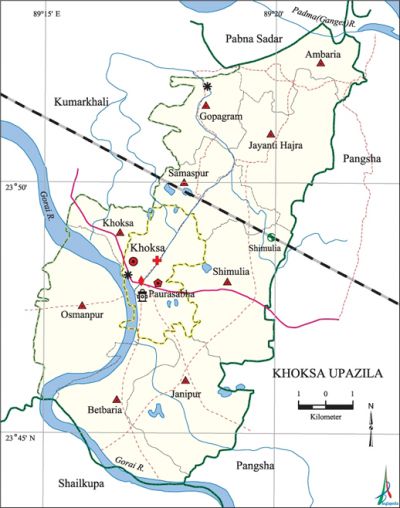Khoksa Upazila
Khoksa Upazila (kushtia district) area 106.70 sq km, located in between 23'44' and 23'53' north latitudes and in between 89'15' and 89'22' east longitudes. It is bounded by kumarkhali and pabna sadar upazilas on the north, shailkupa upazila on the south, pangsha upazila on the east, Kumarkhali upazila on the west.
Population Total 114188; male 58131, female 56057; Muslim 100704, Hindu 13469, Buddhist 13 and others 2.
Water bodies Main river: gorai.
Administration Khoksa Thana was turned into an upazila in 1983.
| Upazila | ||||||||
| Municipality | Union | Mouza | Village | Population | Density (per sq km) | Literacy rate (%) | ||
| Urban | Rural | Urban | Rural | |||||
|
1 |
9 |
85 |
101 |
21303 |
92885 |
1070 |
49.9 |
37.3 |
| Municipality | ||||||||
|
Area (sq km) |
Ward |
Mahalla |
Population |
Density |
Literacy rate (%) | |||
|
12.50 |
9 |
- |
- |
- |
- | |||
| Upazila Town | ||||||||
|
Area (sq km) |
Mouza |
Population |
Density |
Literacy rate | ||||
|
12.54 |
8 |
21303 |
1699 |
49.9 | ||||
| Union | ||||
| Name of union and GO code | Area (acre) | Population | Literacy rate (%) | |
| Male | Female | |||
|
Ambaria 43 |
1857 |
4989 |
4962 |
29.44 |
|
Osmanpur |
539 |
1334 |
1326 |
47.10 |
|
Khoksa 47 |
8520 |
18109 |
17279 |
41.65 |
|
Gopagram |
434 |
3092 |
3016 |
43.07 |
|
Janipur 23 |
5832 |
11937 |
10194 |
41.61 |
|
Jayanti Hajra |
1059 |
1281 |
1267 |
33.05 |
|
Betbaria |
396 |
781 |
726 |
44.41 |
|
Shimulia |
1044 |
2215 |
2131 |
34.56 |
|
Samaspur 71 |
6684 |
14393 |
14056 |
38.68 |
Source Bangladesh Population Census 2001, Bangladesh Bureau of Statistics.
Archaeological heritage and relics Kali temple and Neelkuthi.
Religious institutions Roypur Pirbari Jami Mosque, Fulbari Jami Mosque, Chadot Jami Mosque, Hijlabat Jami Mosque, Uthali Beparipara Jami Mosque, Miabari Jami Mosque, Khoksa Kali Mandir and Fulbari Mandir are notable.

Literacy rate and educational institutions Average literacy 39.7%; male 43.6%, female 35.6%. Noted educational institutions: Khoksa Degree College (1972), Janipur Pilot High School (1900), Fulbari High School (1900), Sengram High School (1907), Iswardi Secondary School (1964).
Newspapers and periodicals Droho (weekly).
Cultural organisations Library 13, theatre group 2, jatra party 2, cinema hall 3, women's organisation 3.
Main sources of income Agriculture 51.90%, non-agricultural labourer 4.68%, industry 10.23%, commerce 15.32%, transport and communication 3.97%, service 6.35%, construction 1.29%, religious service 0.08%, rent and remittance 0.16% and others 6.02%.
Ownership of agricultural land Landowner 51.46%, landless 48.54%; agricultural landowner: urban 24.12% and rural 58.16%.'
Main crops Paddy, wheat, jute, potato, sugarcane.
Extinct or nearly extinct crops Kaun, barley.
Main fruits Mango, blackberry, banana, jackfruit, papaya, litchi.
Fisheries, dairies and poultries This upazila has a number of fisheries, poultries and hatcheries.
Communication facilities Pucca road 54.08 km, mud road 202.70 km; railway 5.2 km; waterway 30 nautical miles. Railstation 1.
Extinct or nearly extinct traditional transport Palanquin, horse carriage, bullock cart.
Noted manufactories Ice factory, rice mill, oil mill,' flour mill, saw mill.
Cottage industries Weaving, potteries, bamboo work, nakshi kantha.
Hats, bazars and fairs Ektarpur Hat, Gadai Hat, Moragachha Hat, Sengram Hat, Ambaria Hat, Fulbaria Hat, Mahish Bathan Rash Mela and Khoksa Kali Mela.
Main exports Jute, sugarcane.
Access to electricity All the wards and unions of the upazila are under rural electrification net-work. However 22.55% of the dwelling households have access to electricity.
Sources of drinking water Tube-well 94.90%, tap 0.89%, pond 0.14% and others 4.07%.
Sanitation 42.59% (rural 59.25% and urban 38.84%) of dwelling households of the upazila use sanitary latrines and 37.16% (rural 29.71% and urban 38.84%) of dwelling households use non-sanitary latrines; 20.25% of households do not have latrine facilities.
Health centres Upazila health complex 1, satellite clinic 2, family planning centre 1, community clinic 9.
NGO activities Operationally important NGOs are brac asa. [Kamruzzaman]
References Bangladesh Population Census 2001, Bangladesh Bureau of Statistics; Cultural survey report of Khoksa Upazila 2007.
